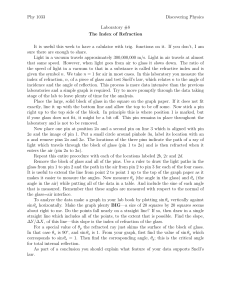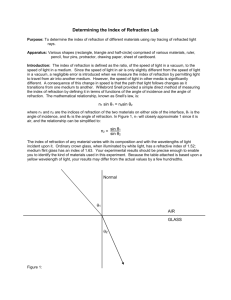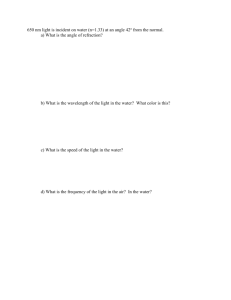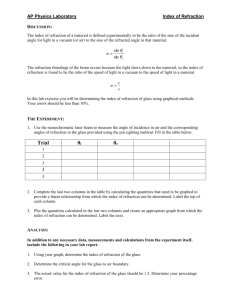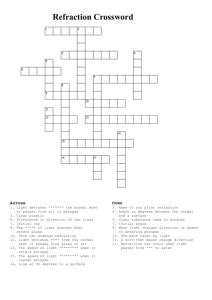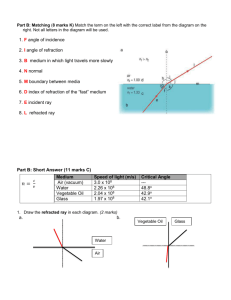Index Of Refraction Of Glass
advertisement
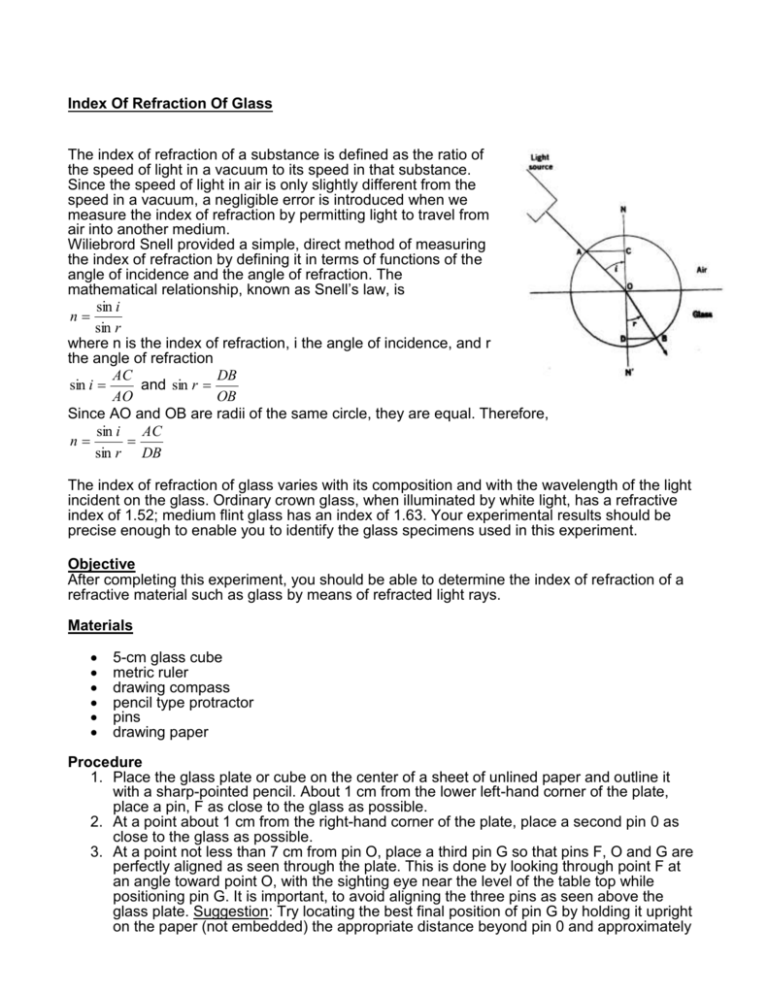
Index Of Refraction Of Glass The index of refraction of a substance is defined as the ratio of the speed of light in a vacuum to its speed in that substance. Since the speed of light in air is only slightly different from the speed in a vacuum, a negligible error is introduced when we measure the index of refraction by permitting light to travel from air into another medium. Wiliebrord Snell provided a simple, direct method of measuring the index of refraction by defining it in terms of functions of the angle of incidence and the angle of refraction. The mathematical relationship, known as Snell’s law, is sin i n sin r where n is the index of refraction, i the angle of incidence, and r the angle of refraction AC DB sin i and sin r AO OB Since AO and OB are radii of the same circle, they are equal. Therefore, sin i AC n sin r DB The index of refraction of glass varies with its composition and with the wavelength of the light incident on the glass. Ordinary crown glass, when illuminated by white light, has a refractive index of 1.52; medium flint glass has an index of 1.63. Your experimental results should be precise enough to enable you to identify the glass specimens used in this experiment. Objective After completing this experiment, you should be able to determine the index of refraction of a refractive material such as glass by means of refracted light rays. Materials 5-cm glass cube metric ruler drawing compass pencil type protractor pins drawing paper Procedure 1. Place the glass plate or cube on the center of a sheet of unlined paper and outline it with a sharp-pointed pencil. About 1 cm from the lower left-hand corner of the plate, place a pin, F as close to the glass as possible. 2. At a point about 1 cm from the right-hand corner of the plate, place a second pin 0 as close to the glass as possible. 3. At a point not less than 7 cm from pin O, place a third pin G so that pins F, O and G are perfectly aligned as seen through the plate. This is done by looking through point F at an angle toward point O, with the sighting eye near the level of the table top while positioning pin G. It is important, to avoid aligning the three pins as seen above the glass plate. Suggestion: Try locating the best final position of pin G by holding it upright on the paper (not embedded) the appropriate distance beyond pin 0 and approximately G 6. 7. 8. 9. aligned with pins F and 0 as viewed above the glass, then looking through the glass plate along the sightline of pins F and 0, slowly move pin G in a clockwise arc until it is observed to pass across the FO sightline. Determine the final alignment point for pin G by moving it slowly back and forth across the FO sightline. 4. Remove the glass plate and join the points F, 0, and G to represent the path of the light ray traveling from pin G through air to pin 0 and through the glass to pin F. Label the incident ray and refracted ray. 5. Construct the normals NO and ON’. Using as large a radius as possible, describe a circle with point 0 as the center that intersects OF, ON’, OG, and ON. From the point of intersection of the circle with the incident ray 0G. draw a line x perpendicular to ON. Measure the length of x to the nearest 0.01 cm and record it in the data table. From the point of intersection of the circle with the refracted ray OF, draw a line y perpendicular to the normal ON’. Measure the length of y to the nearest 0.01 cm and record its value. Using a protractor, measure the angles of incidence i and refraction r to the nearest 0.5. Record in the data table. Data Table Trial X (cm) Y (cm) i () r () Calculations 1. Compute the index of refraction of your glass plate from the measured values of x and y and again from the measured values of angles i and r. Record both results in the calculations table. Identify the kind of glass. 2. Calculate the absolute and relative error. Trial Index of Refraction (x/y) Index of Refraction sin i/sin r Kind of glass Absolute Error Relative Error (%)


